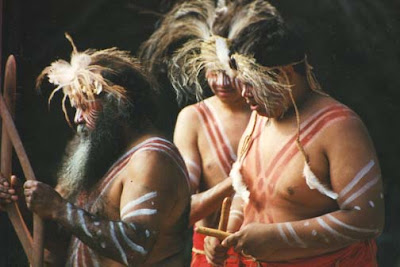
Namawi rawul-inyeri thulun-ar. Our footrpints come from the past. [Kungun Ngarrindjeri Miminar Yunnan, Listen to Ngarrindjeri Women Speaking,
Life lessons are written in Ngarrindjeri Ruwi. Here in waters now known as Loveday Bay, Spiritual Ancestor Nurunderi taught Creation-time fishers not to be greedy, but to share the Thukeri from the waters. At first the fishers took no notice, then they made excuses, and the consequences were dire. Nurunderi changed forever a favourite fish into a bony bream. For tens of thousands of years, the Ngarrindjeri have taught their children not to hoard. For thousands of years the river's waters flowed, Ruwi was healthy and people thrived. This region supported the densest population of First Peoples on the continent.
“You are one with the Earth and the Water. So you're connected through both: Mother Earth and our waters, because the waters are the lifeblood. They're the veins in our bodies in fact, and what's been happening is we've been damaging and blocking our arteries up by building all these locks and weirs and all sorts of other things which has made the system sick,” Matt Rigney, chair of MLDRIN, Murray Lower Darling Rivers Indigenous Nations, explained to SA's Stateline. [Leah MacLennan, “Coorong Drought,”30/05/2008 http://www.abc.net.au/stateline/sa/content/2006/s2262266.htm]
“I think people have to wake up and understand the difference between need and greed and I think there's been far too much greed has been overtaking common sense in regards to managing our waterways,” chided Ngarrindjeri Rupelli George Trevorrow. He warned: “It is an old saying, that once our totems go, we go. So it's a very big concern to us at the moment.”
The Ngarrindjeri are not alone in their concerns. The Murray Darling Basin is home for 75,000 First Peoples, most Traditional Owners. In 1998, as an initiative of the Yorta Yorta, First Peoples all along the river gathered to form MLDRIN (Murray Lower Darling Rivers Indigenous Nations). It's “an expression of the way the Indigenous Nations have always done business.” First Nations have been keeping the rivers healthy for thousands of years by “caring for country and talking to their traditional neighbours upstream and downstream on the Murray and its’ sister Rivers, Creeks, Lakes, Billabongs and waterways.” [MLDRIN - http://www.mldrin.org.au/about/stratplan.htm]
“The Indigenous vision for the river system is holistic – it incorporates spiritual, cultural, economic and social values. All are inter-related. All the issues need to be addressed together,” stated MLDRIN's Report to the Murray Darling Basin Commission in 2003. Thousands of years of respect for the river makes Traditional Owners “best placed to talk for Country,” but the decision-making has been dominated by immigrant, non-Indigenous “stake-holders.”
George Trevorrow pointed out to Stateline: “Every other group has been engaged, particularly irrigators and dairy farmers, rice growers, cotton growers. You name it, they've all been engaged. Aboriginal people have been a tack on. We don't want to be seen as a symbolic symbol or a gesture of symbolism. We want to be a part of the whole process and we want to engage in a proper way."
Ngarrindjeri knowledge of the river's bounty is ancient. In Ngarrindjeri accounts of Creation, Nurunderi chased a great fish Pondi down a little stream and the fish's frantic movements carved a great waterway down to the lakes. There Pondi was cut up, filling the lakes with a diversity of fish. The food supply supported an abundance that amazed Captain Sturt in 1830. From the cliffs at a bend in the river, now known as Tailem Bend, three thousand warriors watched and readied as Sturt's crew rowed downstream. Despite breaking traditional Law of entering Country, Sturt was allowed to pass by circumspect elders.
According to oral history, Ngarrindjeri old people welcomed the British foreigners to Country in their usual way, asking them to look after it. But the foreign Occupiers disrespect for the River over the past two centuries has broken the law of Caring for Country.
“Does anyone have a solution?”
A government minister or two and invited stakeholders had met to discuss the water crisis for the Lower Lakes and Kurangk, my Ngarrindjeri raconteur explained. Giving me a prime-time re-play of proceedings, he shot up his hand and said eagerly:
“I do. All you convicts and hangers-on go home. Then there'd be plenty of water for us blackfellas.”
Those assembled laughed, said my friend, but I could read something very serious in his face. And I realized that Steve Walker, the Chair of Raukkan Community, had said in a few words what it has taken me weeks to write in over 6000!
The Ngarrindjeri spoke up all the way to the High Court but few listened. The River's slow creeping death is now strangling businesses. Fair cop for us. We are not helpless. We can can change from water hoarders to healers. We as a community have to be prepared to pay the repair bill. But not warranted is the cruelty inflicted upon the turtles, the fish, the wading birds, the Australian otters, the water grasses and the mussels which strew the lake-edge in their thousands, their last gasp for life immortalized in the now toxic mud.
An intimately connected web of Nature, the once wealthy delta of the River Murray, is so torn it will be soon impossible to repair.











No comments:
Post a Comment